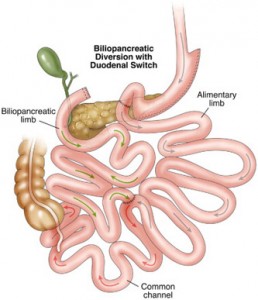About Duodenal Switch Surgery
Duodenal switch surgery is a weight loss procedure that combines both the restrictive and the malabsorptive surgical techniques.The restrictive technique involves the reduction of stomach size. The surgeon divides the stomach vertically and gets rid of 67-75% of it reducing the quantity of food one can eat, and enhances quicker fullness leaving a banana shaped stomach of approximately 150 millilitres. This surgery keeps a small portion of the duodenum, the first part of the ileum in the digestive tract.
The malabsorptive component, on the other hand, involves a rearrangement of the ileums to separate food flow from the flow of digestive juices and allows malabsorption where the food and digestive juices mix, approximately 22 inches down the intestines. This component, unlike the restrictive component, is reversible if one experiences malabsorbtive complications later.
Who Goes for Duodenal Switch Surgery
To qualify for duodenal switch surgery an individual has to have a BMI body mass index of not less than 40. Diabetic individuals with a BMI of less than 40 may also be considered for the surgery. However, this surgery usually produces better weight loss results in individuals with a BMI of 50 or more.
 Duodenal switch surgery is not advocated for high risk individuals, especially those with heart problems and sleep apnea. Irrespective of the weight loss surgery method one chooses, the preparations involve making life long commitments to the changes in diet and lifestyle that come with it.
Duodenal switch surgery is not advocated for high risk individuals, especially those with heart problems and sleep apnea. Irrespective of the weight loss surgery method one chooses, the preparations involve making life long commitments to the changes in diet and lifestyle that come with it.
The evaluations before this bariatric procedure involve discussing with a dietician of the diet changes that may take place before and after the surgery, professional evaluation of the patient’s mental health, upper endoscopy examination to ensure no tumours, polyps, ulcers or ulcer causing bacteria present in the stomach. Lifestyle changes that may occur before the surgery involve; quitting smoking before and after the surgery and no alcohol consumption at least 48 hours before surgery. It is advisable that the patient loses 5 to 10% of excess weight for a shorter hospital admission and a faster weight loss after operation. Ask Dr Cataneda for more information.
Benefits of Duodenal Switch
Duodenal switch surgery has a higher weight loss percentage for overweight individuals due to its combination of the restrictive and malabsorptive techniques. Research also shows that type 2 diabetics become almost wholly cured after the surgery because of the metabolic effect of the switch of intestines. Individuals who undergo this surgery are reported to have a larger stomach capacity compared to other procedures and because the pylorus is kept intact, most of the individuals do not suffer the dumping syndrome later.
Some Risks for Consideration
There is a very high level of technical skill required in this procedure and is offered by just a few specialist bariatric surgeons such as Dr Castaneda Cruz. Patients that have taken this surgery have been reported to suffer at times greater blood loss in operation, stayed longer in the hospital, and needed more subsequent surgeries after the main surgery. The risks involved with this procedure include spleen injury in surgery, leaks, blood clots travelling to the lungs, bowel obstruction, healing problems at incision site resulting to infection and even kidney failure. Some long term complications include nutritional deficiencies like Vitamin A, D, Calcium and proteins that can be prevented with appropriate supplements. Before taking this surgery, it is highly recommended that the degree of risk exposure be balanced with the health risks associated with obesity.


